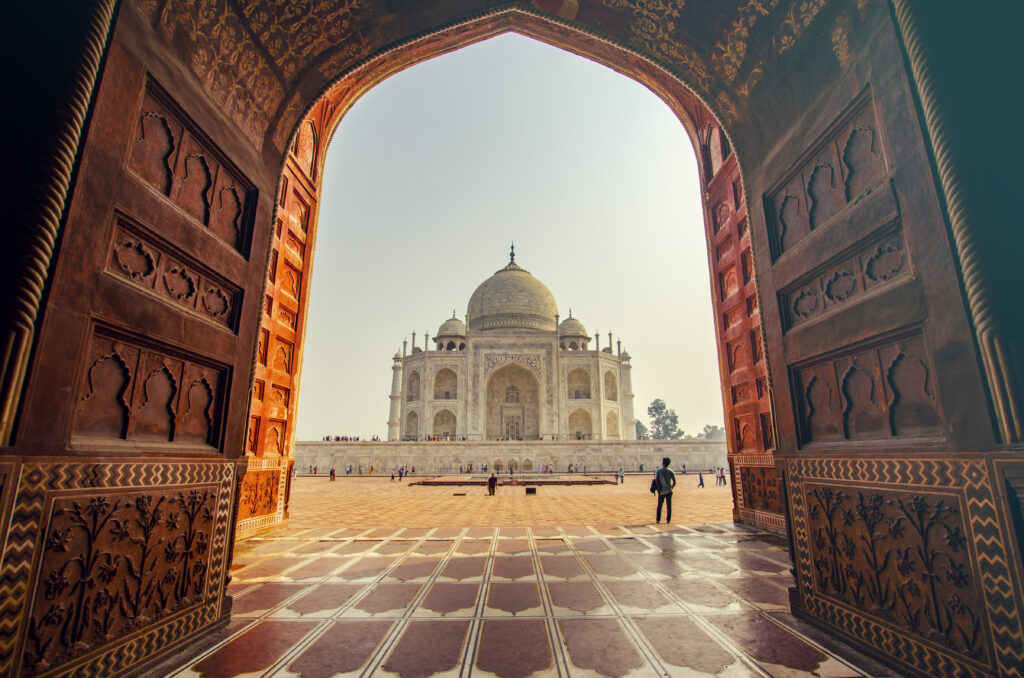Welcome to Agra, a city that preserves the Mughal Empire’s past! One of the most potent empires in history was the Mughal Empire, which ruled over India from 1526 until 1857. And during the 16th and 17th centuries, Agra served as the imperial capital. The Mughal Emperors left an enduring impression on Agra through their art, culture, and traditions as well as through the palaces they erected.
Agra was at the fore of this movement throughout the Mughal era, a period of enormous cultural and creative progress. The Mughal Emperors were ardent supporters of the arts and invited artisans and artists from all over the world to exhibit their work in Agra.
The Taj Mahal: A Picture of Art and Love

The Taj Mahal must be brought up when discussing the Mughal legacy in Agra. The Taj Mahal, one of the seven wonders of the world, was constructed by Emperor Shah Jahan in honour of his cherished wife Mumtaz Mahal. This magnificent structure, which is composed completely of white marble, serves as a reminder of the Mughal era’s workmanship, art, and architecture.
The Taj Mahal is a representation of the Mughal Empire’s superior cultural and creative achievements in addition to being a symbol of love. The Taj Mahal is a remarkable masterpiece because of its fine inlay work, stunning calligraphy, and detailed sculptures.
Mughal craftsmanship and art
An original form of artwork and workmanship that incorporated Central Asian, Persian, and Indian inspirations emerged during the Mughal Empire. Complex patterns, delicate motifs, and vivid colours defined this fashion.
Some of the Mughal era’s finest skilled artisans and craftspeople came from Agra. The city was renowned for its fine pottery, jewellery, and textiles. During this time, miniature painting flourished in Agra as well, with artisans producing breathtaking small works of art.
Mughal customs and culture
The Mughal Empire was renowned for its voluminous customs and culture. The growth of various art forms in Agra was supported by the Emperors, who were ardent supporters of dance, music, and literature.
Some of the finest skilled musicians and dancers of the Mughal Empire called the city home. The Mughal Emperors were accomplished poets and writers who contributed to the development of the Urdu language, which is still extensively used today in Pakistan and India.
Additionally, Agra had a big influence on how Mughal food evolved. Mughal cooks produced some of the most delectable and intricate meals of the era using the exotic spices and ingredients that could be found in the city’s markets.
The Legacy Stays
Although the Mughal Empire was destroyed centuries ago, Agra still bears the marks of its presence. In this dynamic metropolis, the magnificent structures, works of art, traditions, and cultures of the Mughal Empire are still very much present.
A trip to the city would not be complete without learning about the Mughal heritage. Marvel at the Taj Mahal’s stunning architecture, be astounded by the exquisite intricacies of Mughal art and workmanship, and indulge in the flavours of Mughal cuisine. The history of the Mughal Empire is ready to be learned, and Agra is waiting to be explored.
Discover the Magnificent Mughal Legacy at Tree of Life – Ecotainers Resort in Agra During your opulent stay with us, immerse yourself in the city’s majestic history and grandeur. Discover the ideal fusion of eco-luxury and tradition while being surrounded by quiet natural beauty. Make a reservation today to start an incredible trip through time at the legendary Taj Mahal’s doorstep.







